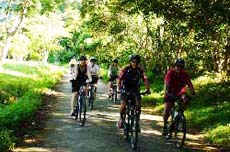One of the nation's larg-est rainforests in Cuc Phuong National Park in the northern province of Ninh Binh has become a hot destination for adventure and nature lovers, complete with wildlife treks and homestays in the communes of Thai and Muong ethnic groups.
 |
| Pedal pushers: Foreign tourists bike along a path through Cuc Phuong National Park. |
Located in the triangle formed by Hoa Binh, Ninh Binh and Thanh Hoa, 120km southwest of Ha Noi, the park is just three hours away from the capital.
The 22,200ha park – home to 2,000 primates, flora, fauna, a series of caves and several big lakes – was established in 1962 by the Government to preserve forest ecosystems in the northern part of the country.
Over 300 species of birds have been recorded at Cuc Phuong Park, including red-headed woodpeckers, silver pheasants and the pitta brachyura.
An Endangered Primate Rescue Centre was built to protect endangered animals, including Delacour's Langur, the Gray-shanked Douc Langur and the Golden Headed Langur, all of which are endemic primates that exist only in Viet Nam.
In spring, between March and May, the park is aflutter with countless butterflies and covered in wild flowers.
"The park hosts around 100,000 tourists annually and the park's accommodations can hold around 300 visitors a night," the park's tour operator, Do Hong Hai, said.
Wildlife trekking
A special wildlife tour was first organised six years ago, but it still only draws a limited number of adventurers, as the number of wild animals in the park have dramatically decreased in recent years.
The park's staff suggested that tourists should come during the dry season between September and December.
 |
| Protection seeking: Cuc Phuong Park is home to the Delacour's langur, which is listed as one of the world's 25 most endangered primates. |
"Tourists will have more trouble during the rainy season, as leeches and mosquitoes are everywhere. However, in the dry season you won't be as exhausted after your treks," Hai said.
He said that it's very rare chance to see leopards, tigers or bears at night because the number of animals has been reduced due to climate change and illegal poaching.
However, he said that the owston civet, the giant black squirrel, the Indian flying squirrel and the loris could be seen between 7pm and 9pm most days.
"You can catch the glowing eyes of the civets, squirrels and loris very often these days. The two hours you will spend tracking them down at night will give you an unforgettable experience and a sleepless night!" Hai said.
Prehistoric cave
Cuc Phuong Park is also well-known for its prehistoric cave.
The limestone cave, which was excavated in 1966, was one of the earliest discoveries of human habitation in the country, with graves, stone axes, bone-made spears and tools dating back some 7,500 years.
During the excavation 44 years ago, archaeologists found skeletons in three tombs where they believed prehistoric people had lived in the forest 7,500 years ago.
In 2000 archaeologists discovered a fossilised sea reptile called placodontia, the first to have been found in Southeast Asia, dating back 200-300 million years.
Visitors can also trek through a primary forest of century-old trees to meet the giant cho tree (parashrea stellata), believed to be around 1,000 years old.
Living with the locals
Khanh Commune – home to 100 Muong people – is the one of six communes recognised as a place to make a homestay by the park administration.
The Muong ethnic commune is an ideal place to stop for the night after an entire day of walking around. Tourists can spend the night and see traditional folk dances around a camp fire at night.
"The travellers can dance along with the locals, and roast potatoes and cassava roots for dinner. A cheerful night in the stilt house will refresh you for your next day's journey," said tour guide Le Vu Ha.
Ha said that rafting along the Buoi River was a favourite pastime for travellers.
"It's very interesting. Local people use bamboo rafts to cross the river, and travellers can try their hands at rowing them," Pham Van Cuong, a guide from a Ha Noi-based travel agency, said.
"Travellers can row themselves along the river, which is surrounded by rice paddies and corn fields."
Travellers can also get a bus from the Ha Noi-based Giap Bat station to Cuc Phuong at 3pm each day, for a price of VND65,000. Another bus leaves the station for Nho Quan District, but it needs another 25km drive on a xe om (motorbike taxi) to reach the park.